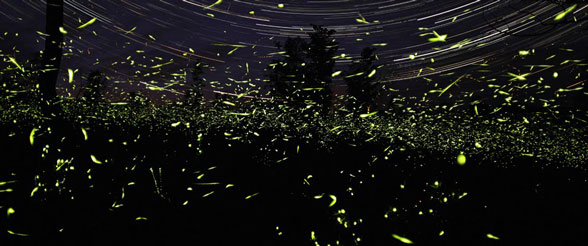


Thousands of fireflies, called kelip-kelip in Malaysia - their name is a sort of visual onomatopoeia for their twinkling - can settle on riverside trees. Reports of fireflies flaring in unison in Southeast Asia filtered back to Western scientific discourse for centuries. “Now we can start closing the loop.” The Elusive Proof of Synchrony “That’s the big breakthrough,” said Strogatz, a professor of mathematics at Cornell University. Mathematicians devising theories of synchrony like the ones that Strogatz described in his textbook, meanwhile, have operated without much experimental feedback from messy real-world synchronizers. An even more recent preprint, first uploaded in May and updated last week, documented a rare type of synchrony that mathematicians call a chimera state, which has almost never been observed in the real world outside of contrived experiments.įirefly biologists hope the new methods will reshape the science and conservation of fireflies. A preprint that Peleg’s group posted in March, however, showed that in at least one species, individual fireflies have no intrinsic rhythm, and it posited that a collective beat emerges only from the spooky synergy of many lightning bugs gathered together. Nearly every model for firefly synchrony ever concocted, for example, assumes that each firefly maintains its own internal metronome. These papers establish that real firefly swarms depart from the mathematical idealizations that flitted through journals and textbooks for decades. “I was blown away,” said Andrew Moiseff, a biologist at the University of Connecticut. “Pretty astonishing” is how the mathematical biologist Bard Ermentrout at the University of Pittsburgh described the team’s results to Quanta.
#SYNCHRONIZED LIGHTNING BUGS SERIES#
In the last two years, a series of papers from Peleg’s group have opened a fire hose of real-world data about synchrony in multiple firefly species at multiple study sites, and at a much higher resolution than previous modelers or biologists had managed. But by the time Peleg began her own lab, applying computational approaches to biology at the University of Colorado and at the Santa Fe Institute, she had learned that although fireflies had inspired a lot of math, quantitative data describing what the insects were actually doing was scant. “It’s just so beautiful that it somehow stuck in my head for many, many years,” she said.

Peleg had never even seen a firefly, as they are uncommon in Israel, where she grew up. The fireflies were presented as an example of how simple systems achieve synchrony in Nonlinear Dynamics and Chaos, a textbook by the mathematician Steven Strogatz that her class was using. Orit Peleg remembers when she first encountered the mystery of synchronous fireflies as an undergraduate studying physics and computer science. The fireflies’ light shows lure mates and crowds of human sightseers, but they have also helped spark some of the most fundamental attempts to explain synchronization, the alchemy by which elaborate coordination emerges from even very simple individual parts. In Malaysia and Thailand, firefly-studded mangrove trees can blink on beat as if strung up with Christmas lights every summer in Appalachia, waves of eerie concordance ripple across fields and forests. Physicists revere fireflies for reasons that might seem every bit as mystical: Of the roughly 2,200 species scattered around the world, a handful have the documented ability to flash in synchrony. And across various Western cultures, fireflies, glow-worms and other bioluminescent beetles have been linked to a dazzling and at times contradictory array of metaphoric associations: “childhood, crop, doom, elves, fear, habitat change, idyll, love, luck, mortality, prostitution, solstice, stars and fleetingness of words and cognition,” as one 2016 review noted. Some Indigenous cultures in the Peruvian Andes view them as the eyes of ghosts. In Japanese folk traditions, they symbolize departing souls or silent, ardent love.


 0 kommentar(er)
0 kommentar(er)
